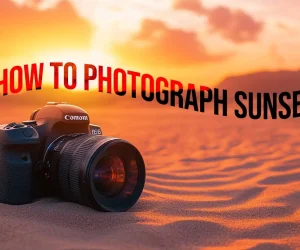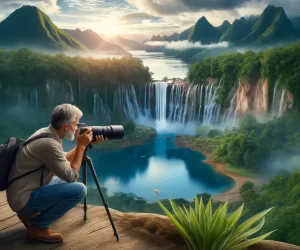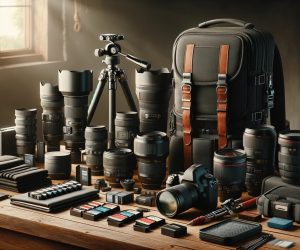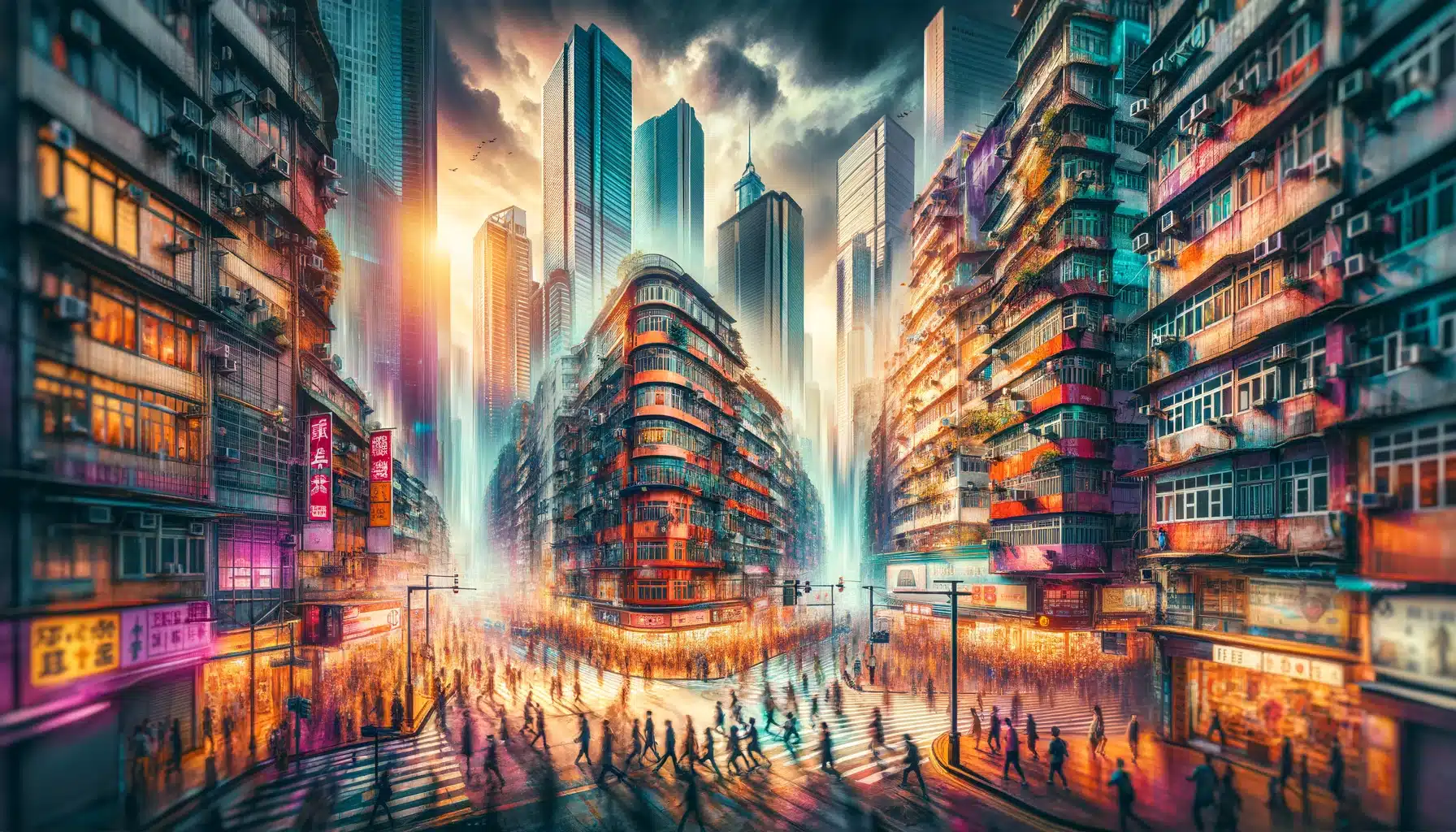
Street Photography Unveiled: Capturing Life's Unscripted Symphony
Welcome to the dynamic and unpredictable world of Street Photography. Capturing the rhythm of life on the streets is an exhilarating experience that constantly challenges photographers. Unscripted and spontaneous, it becomes a testament of time encapsulated in a photo.
Mastering street photography requires a keen eye and instinct. It thrives on noticing interesting people, anticipating scenarios, and being at the right place at the right time. Shooting in public doesn’t always mean capturing faces. Subjects can vary from shooting a don of colors at dawn or waiting for that one decisive moment where the composition tells a compelling story.
The goal is to create photographs that the ordinary viewer wouldn’t see or notice. Successful street photographers anticipate and observe, patiently waiting for the perfect shot. From the dance of shadows to the interaction of strangers, street photography is a beautiful symphony of art waiting to be captured by your camera. Let’s move ahead and learn more about this fascinating genre, delving into the art of street photography.
Table of Contents
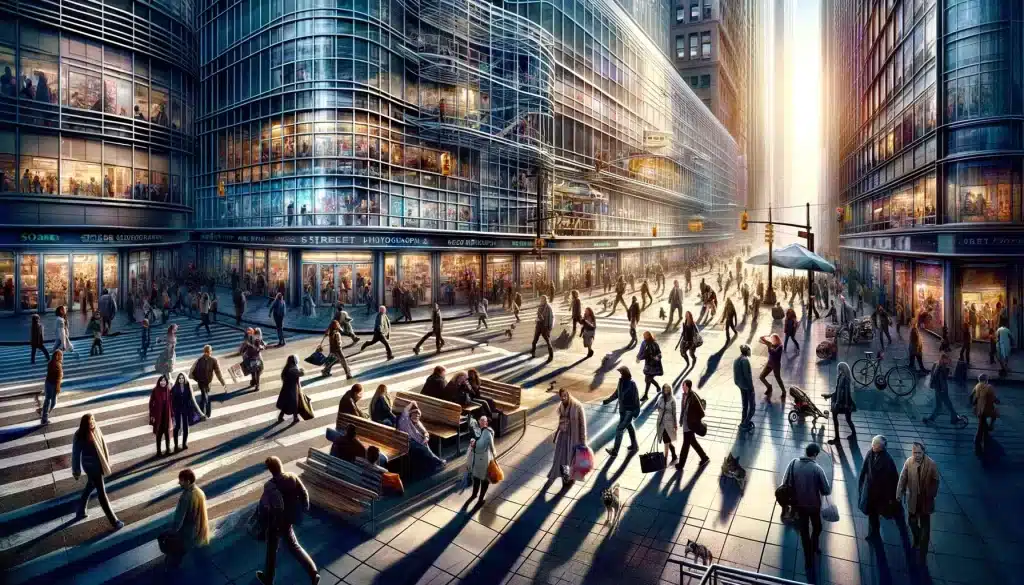
Understanding the Basic Concepts of Street Photography
Exploring the bustling streets through the lens of your camera allows you to capture the raw and unfiltered essence of urban life. From the dynamic expressions of pedestrians to the intricate play of light and shadow, every shot tells a unique story.
However, mastering the art of street photography requires more than just an eye for interesting scenes; it demands a keen understanding of several crucial techniques and an innate ability to anticipate the unexpected.
Choosing the Right Equipment
While the gear does not make the photographer, selecting the right tools can significantly aid in capturing high-quality street scenes. A light, unobtrusive camera that blends into the surroundings boosts your ability to capture candid moments without drawing attention.
Fixating on a prime lens known for its wide aperture will help in low light conditions and allow for a more intimate depth of field in your shots.
Mastering the Technical Aspects
Understanding the manual settings of your camera is paramount.
Adjusting the ISO, shutter speed, and aperture according to the lighting and the effect you wish to achieve can transform your photographs from good to extraordinary.
Practicing these adjustments will enable you to quickly adapt to the ever-changing lighting conditions of the streets.
Developing a Keen Eye for Composition
- Look for Patterns and Symmetry: Urban environments are rich with geometric shapes and lines. Use these elements to add a compelling structure to your images.
- Play with Perspectives: Get high above or down low on the ground for unique viewpoints. Changing your perspective can reveal intriguing compositions in ordinary scenes.
- Embrace Negative Space: Sometimes, what you leave out of the frame is as important as what you include. Negative space can add a powerful visual impact to your photographs.
The Ethical Consideration
Street photography often involves capturing people in public spaces without their explicit consent. It’s essential to approach this aspect with sensitivity and respect. If questioned, explain your art. Remember, good ethics and respect for privacy foster positive interactions and can lead to remarkable photos.
Post-Processing Techniques
The work isn’t done once you press the shutter button. Post-processing plays an invaluable role in bringing out the best in your images, whether raw or jpeg. Tools like figuring backlighting and image distortion can be pivotal in enhancing your photographs while maintaining their natural look. It’s not about altering the reality of the shot but about refining the story it tells.
Capturing the essence of street life through photography is an exciting challenge that rewards persistence and creativity. Every foray into the urban landscape is an opportunity to witness and document the unique stories unfolding around us. By honing your skills and understanding the soul of street scenes, you can turn fleeting moments into lasting narratives.
By integrating these insights and techniques into your practice, you’ll not only hone your craft but also deepen your connection with the vibrant world of street photography. Through patience and perseverance, the streets will unveil their stories, waiting for you to capture them.

Essential Equipment For Quality Street Photography
To excel in street photography, embracing the right tools and techniques is fundamental. This genre captures the essence of everyday life, requiring a photographer to blend in, yet remain poised to seize fleeting moments with precision and flair. Here are essential considerations and equipment to amplify your street photography prowess.
Optimizing Your Gear for Flexibility and Stealth
- Choosing a Discreet Camera: Compact mirrorless cameras are preferred for their less intrusive appearance. Prioritize models with silent shooting modes to remain unnoticed.
- Selecting Versatile Lenses: A prime lens with a wide aperture offers sharpness and a beautiful bokeh, helping your subjects stand out against bustling street scenes. A 50mm lens, often referred to as the “nifty fifty,” provides a field of view similar to the human eye, ideal for candid scenarios.
- Investing in a Durable Camera Strap: A robust strap enables quick access to your camera, ensuring you’re always ready. Consider a cross-body strap for added security and comfort during extended walks.
Exploring innovative angles and compositions captures the dynamism of the streets. Utilize reflections, shadows, and architectural lines to guide the viewer’s eye through your photographs. Moreover, interacting with your environment can unveil unique perspectives.
At times, the unpredictable lighting of outdoor settings poses a challenge. A portable reflector or a small LED light can help balance shadows and highlights, bringing harmony to your captures. Remember, the magic often lies in embracing imperfections, allowing for a more authentic portrayal of your vision.
Enhancing Your Skills with Post-Processing
Mastering post-processing tools significantly improves the quality of your street photography. Programs like Adobe Photoshop provide a suite of features to refine your images:
- Discover how the Quick Selection tool streamlines editing by efficiently isolating subjects. This feature, detailed at Quick Selection tool in Photoshop, simplifies adjustments and corrections.
- Learn the art of using the Clone Stamp Tool to remove unwanted distractions from busy backgrounds, enhancing focus on your primary subject. Additional information can be found at How To Use Clone Stamp Tool.
To boost engagement, consider placements for captivating images showing your equipment in action or before-and-after shots demonstrating post-processing effects. Such visual aids not only break the text but also provide real-world applications of the discussed tools and techniques.
For those eager to capture life as it unfolds, mastering street photography is an ongoing process of learning and adaptation. The right equipment, coupled with a creative and observant eye, empowers you to tell compelling stories through your lens. Explore further techniques and tools at What is Street Photography? to deepen your understanding and refine your approach. This knowledge base will guide you through harnessing the spontaneity and vibrancy of the streets, transforming ordinary scenes into extraordinary snapshots of life.
Practical Techniques for Capturing Candid Street Photos
Exploring urban environments and capturing the essence of daily life, street photography offers unique challenges and rewards. This section delves into novel tactics for obtaining genuine candid shots that tell stories.
Firstly, understanding your environment plays a pivotal role in candid street photography. Each neighborhood has its rhythm, and blending in allows you to anticipate and capture genuine moments without drawing attention.
Strategies for Getting Closer to Your Subjects
To achieve compelling candid shots, getting close to your subjects is often necessary. Employing a compact, discreet camera enhances your ability to move unobtrusively. Mirrorless cameras, known for their smaller size, are perfect for this purpose.
Use Natural Light to Your Advantage
- Early morning and late afternoon provide soft, golden light ideal for capturing the mood of the streets. Example: Check these portrait ideas.
- Overcast days offer diffused light, reducing harsh shadows and highlighting details in your scenes.
Embrace the Human Element in Street Photography
Candid street photos gain depth and intrigue from human expressions and interactions.
Focus on:
- Emotions and expressions in crowd.
- Unexpected interactions between individuals.
- People in contrast with their surroundings.
Incorporate Motion for Dynamic Images
Utilizing slower shutter speeds to blur movement can add a layer of dynamism to your shots. This technique is particularly effective in busy urban settings where the flow of people and vehicles illustrates the city’s pulse.
For those looking to refine their post-processing skills, mastering tools such as Refine Edges in Photoshop can significantly improve the quality of your street photography. Similarly, How to Remove Background in Photoshop offers detailed guidance on enhancing the focus on your main subject by removing distracting elements.
Legal Considerations
Always be aware of local laws regarding photography in public spaces. Respecting privacy and obtaining consent when necessary ensures ethical practices in street photography.
Visual aid suggestion: Infographic summarizing key techniques for capturing candid shots.
By employing these techniques, photographers can create captivating images that reflect the spontaneity and vibrancy of street life. Each candid photo serves as a snapshot of humanity, encapsulating fleeting moments that might otherwise go unnoticed. Consequently, photographers not only become better at their craft but also more attuned observers of the human condition.
To further improve your photography and editing skills, exploring the versatile uses of Content-Aware Fill in Photoshop can be incredibly beneficial. This powerful tool assists in cleaning up your shots and bringing the viewer’s focus exactly where you want it.
Tools such as this one are not just useful in street photography but in all kinds, such as even quarantine photography.
Adobe Photoshop Tools for Editing Street Photography
Refining Your Street Imagery Concepts with Photoshop
Street photography captures the unstaged, raw moments of life, often brimming with stories and a powerful sense of place. However, even the most spontaneous shots can benefit from a touch of post-processing magic. Adobe Photoshop offers a plethora of tools designed to refine and enhance these moments, ensuring your imagery resonates with viewers. Let’s explore some transformative tools within Photoshop that can elevate your street captures.
Transform Perspectives with the Transform Tool
| Step | Action | Description |
|---|---|---|
| 1 | Select Image Layer | Start by selecting the image layer you wish to adjust. |
| 2 | Navigate to Transform | Navigate to Edit > Transform, and choose from the options. |
| 3 | Choose Transform Option | Options include Scale, Rotate, Skew, or Warp to adjust your image’s perspective. |
| 4 | Application | This is invaluable for correcting distortions in buildings or aligning the horizon perfectly within your frame. |
Enhance Depth with Dodge and Burn in Post-Processing
- Locate the Dodge and Burn tools from the toolbar. These are ideal for adding depth and contrast to highlight specific areas of your image or adding shadow to others, creating a more dynamic scene.
- Use Dodge to lighten parts of your image and Burn to darken others. Be subtle in your approach to maintain naturalism.
Spot Healing for Seamless Corrections
Removing distractions or undesired elements from your street scenes is straightforward with the Spot Healing Brush Tool. Simply select the tool, adjust the brush size, and click on the area you want to address. Photoshop automatically samples surrounding areas to fill in the selected spot, often leaving no trace of the edit.

Mastering Color Adjustments
- Use the Color Balance and Hue/Saturation adjustments to modify the mood and feel of your images. Access these options through the Adjustments panel.
- Experiment with different settings to see how they affect the atmosphere of your photographs. Remember, subtle changes can make a significant difference.
Utilizing Adobe’s Content-Aware Fill
For more extensive background replacements or the removal of larger objects, the Content-Aware Fill tool is remarkably effective. It analyzes the entire image to suggest the best fill for the selected area, allowing for more complex edits without disrupting the overall integrity of the photo.
Integrate Adobe Smart Objects
Converting your layer into a Smart Object before performing transformations or applying filters preserves your original image data. This non-destructive editing method is essential for maintaining the highest quality of your images throughout the editing process. To do this, simply right-click on your image layer and select Convert to Smart Object.
Adobe Photoshop remains an indispensable tool for street photographers seeking to polish their captures. By harnessing the power of these advanced editing tools, you can transform good photos into great ones. The key is to maintain the spontaneity and authenticity that defines street photography while utilizing Photoshop’s capabilities to subtly enhance the narrative and emotional impact of your images. Explore these tools and discover how they can bring a new dimension to your street photography portfolio.
Common Challenges and Solutions in Street Photography
In the exploration of street photography, enthusiasts grapple with various obstacles that may impede capturing the essence of urban life. Tackling these challenges head-on with innovative solutions not only enhances the quality of the work but also solidifies an individual’s distinct style in this genre.
Adjusting to Swiftly Changing Lighting Conditions
- Utilize reflectors: An immediate method to control harsh sunlight or to brighten shadows.
- Adjust ISO settings: Boost your ISO in dim conditions; ensure it’s as low as possible in bright light to maintain image quality.
Navigating Crowded Locations
Finding a vantage point in crowded areas allows for an unobstructed view. Look for higher ground or use architectural elements to your advantage. Also, shooting during less crowded times, such as early morning, can significantly reduce the struggle with crowds.
Creating Authentic Interactions
Long lenses might seem appealing for candid shots from afar, but they can detach the photographer from the scene. Instead, opt for wider lenses and get closer to your subjects. This approach not only makes compositions more intimate but encourages more genuine interactions between the photographer and the subject.
Maintaining Street Legality
Always be aware of local laws regarding privacy and public photography. In some areas, photographing individuals without consent can lead to legal troubles. A cautious approach and sometimes simply asking permission can save a lot of hassle.
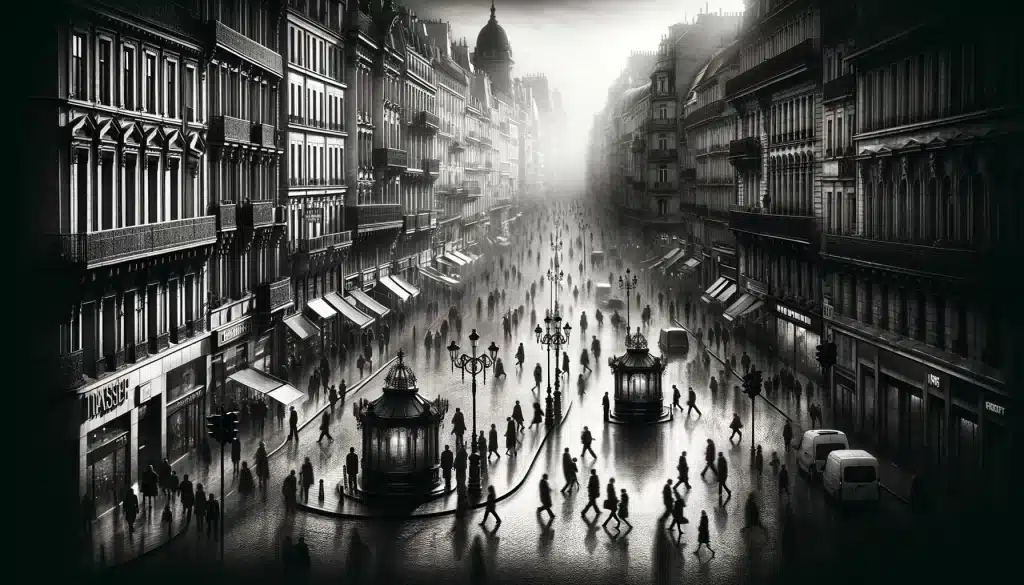
Choosing the Right Moment for Monochrome
Black and white photography can lend a timeless quality to street images. However, recognizing the right moment and scene for monochrome is key. Look for scenes with strong contrasts, interesting textures, or where color doesn’t add to the story.
For more expert advice on editing to ensure your finished photos reflect your envisioned style, exploring resources like the Essential Tools in Photoshop can be immensely beneficial.
In synthesizing these strategies, photographers not only overcome prevalent challenges in the field but also greatly improve their craft. Through practical application and continual learning, such as deepening one’s knowledge of What is Street Photography?, individuals refine their ability to document the vibrancy and nuances of street life.
Street photography, with its unpredictable nature and reliance on spontaneity, thrives on the photographer’s ability to swiftly adapt to their environment and subjects. By embracing these solutions, photographers will find themselves better equipped to capture the fleeting moments that embody the soul of the street.
Key Considerations for Potential Street Photographers
Before your journey as a street photographer, weigh these considerations to enhance your craft:
| Consideration | Description |
|---|---|
| Camera Selection | Equip yourself with a camera that is discreet and swift. |
| Observation Skills | Hone the art of observing and anticipating moments. |
| Narrative Development | Develop a narrative or theme for your street captures. |
| Ethics and Laws | Familiarize yourself with street photography ethics and local laws. |
By integrating these practices, photographers can more effectively capture the essence of the streets.
Adding visual elements such as an exemplary gallery of street shots or a bullet list of ‘must-have’ gear can augment the appeal and readability of this section.
Frequently Asked Questions (FAQs)
How do you define street photography?
Street photography, at its core, is a type of documentary photography that captures everyday life in public spaces. Its essence lies in the candid capture of spontaneity and the human condition within urban environments. Bold explorers of this genre often consider these elements as crucial:
- Unrehearsed scenes
- Authentic expressions and actions
- Dynamic urban backgrounds
Visual storytelling and a keen observational eye are indispensable tools for anyone venturing into this domain of photography.
What is the main purpose of street photography?
The ultimate goal of street photography is to encapsulate and convey the zeitgeist—or spirit of the time—through images of public locales. It seeks to:
- Chronicle societal norms and customs
- Open a window into the collective human experience
- Pose questions about everyday realities
As every snapshot showcases a fraction of existence, they collectively offer rich insights into cultural and social narratives.
Is street photography easy?
While the entry barriers to street photography are low, requiring minimal equipment, the craft itself demands a mix of dedication, intuition, and soft skills, such as:
- Patience for the decisive moment
- Prompt reflexes
- Compassion and respect for subjects
Evolving one’s craft to create poignant and resonating images can indeed be challenging but rewarding.
What is a street photo called?
A single image produced within the realm of street photography is often referred to as a street shot or street capture. These terms represent the instantaneous nature of snapping an unposed scene in a public place. A street shot is often characterized by its serendipitous and fleeting qualities, encapsulating a slice of life as it unfolds.
What is Street Photography Conclusion
In conclusion, mastering street or urban photography involves honing your ability to capture the magnetic pull of everyday life as it unfolds on the streets.
The bustling crowds, the imposing architectures, the play of dramatic lighting, and the riot of colors are the elements that weave the narrative of your shot. Indeed, it’s an on-going learning process to spot the hidden beauty in chaos, to decode the subtle expressions of people, and envision a grand frame within the public sphere, thus requiring a keen eye, patience and, above all, a passion for narrative, reality, as well as candid photography.
Moreover, utilizing powerful editing tools like Photoshop and Lightroom can make your shots even more compelling. Enhancing clarity, adjusting tones, and implementing other edits can bring your vision to life, transforming a regular shot into a mesmerizing artwork. With dedication and the right tools, anyone can conquer the world of street photography, crafting tangible dreams out of fleeting, everyday moments.
If the “What is Street Photography?” article has helped you, then Like and Share it with your friends!





